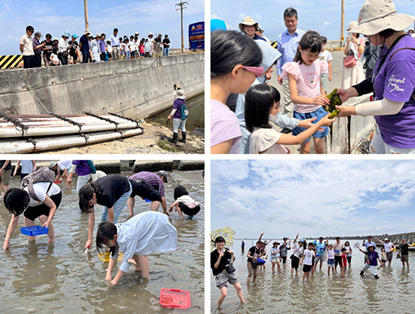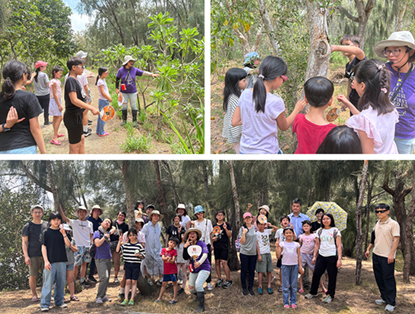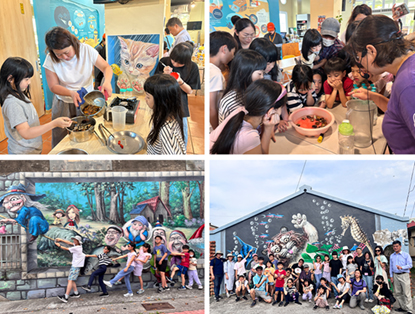Sketch of Archilife Study Tour, April 2025
|
2025年4月份見識之旅縮影  2025年4月20日由呂明澐小姐帶領28位見習生及其家長們,至嘉義縣布袋鎮好美里進行布袋好美里蛤蜊五感體驗之旅。本次行程由好美船屋的鄭怡雯執行長全程帶領,好美里位在淡水與海水交界,微生物豐富,擁有養殖文蛤的優勢,前往養殖區的途中,鄭執行長生動地闡述虱目魚與文蛤之間的生物鏈關係,並介紹當地以音波餵食系統訓練虱目魚群集中進食,搭配益生菌發酵處理的下雜魚餌,不僅提升其蛋白質與鈣質吸收,更體現現代化養殖管理的創新應用;在魚塭管理方面,鄭執行長亦詳述多項關鍵措施,包括曝曬殺菌、翻土促使文蛤潛伏、挖掘深溝為石斑魚提供越冬避寒空間,以及運用石灰與茶粕進行酸鹼中和等技術。緊接著進行摸蛤蜊體驗,由於適逢漲潮,海水覆蓋沙面,眾人無法直接目視文蛤蹤跡,只得赤腳踏入水中,俯身以手腳觸覺細心探索,當腳趾輕觸細沙,偶爾碰觸到隱藏其下的堅硬物體,便可能是潛伏的蛤蜊,探索過程中驚呼與笑聲此起彼落,每一次觸碰皆彷彿與自然展開一場無聲的互動。 2025年4月20日由呂明澐小姐帶領28位見習生及其家長們,至嘉義縣布袋鎮好美里進行布袋好美里蛤蜊五感體驗之旅。本次行程由好美船屋的鄭怡雯執行長全程帶領,好美里位在淡水與海水交界,微生物豐富,擁有養殖文蛤的優勢,前往養殖區的途中,鄭執行長生動地闡述虱目魚與文蛤之間的生物鏈關係,並介紹當地以音波餵食系統訓練虱目魚群集中進食,搭配益生菌發酵處理的下雜魚餌,不僅提升其蛋白質與鈣質吸收,更體現現代化養殖管理的創新應用;在魚塭管理方面,鄭執行長亦詳述多項關鍵措施,包括曝曬殺菌、翻土促使文蛤潛伏、挖掘深溝為石斑魚提供越冬避寒空間,以及運用石灰與茶粕進行酸鹼中和等技術。緊接著進行摸蛤蜊體驗,由於適逢漲潮,海水覆蓋沙面,眾人無法直接目視文蛤蹤跡,只得赤腳踏入水中,俯身以手腳觸覺細心探索,當腳趾輕觸細沙,偶爾碰觸到隱藏其下的堅硬物體,便可能是潛伏的蛤蜊,探索過程中驚呼與笑聲此起彼落,每一次觸碰皆彷彿與自然展開一場無聲的互動。For the study tour of April 20, 2025, Ms. Lu Ming-yun led 28 ARF interns and their parents on a trip to learn about clams in Haomei Village of Budai Township, Chiayi. Located at an estuary, the water of Haomei Village is teeming with microbes ideal for clam farming. On the way to the clam farm, Cheng Yi-wen, tour guide and chief executive officer of Haomei Boat House, explained the food chain that links milkfish and clam, and introduced sound wave feeding system that was used to train milkfish to gather for feeding, and probiotics-fermented fish feed that improved protein and calcium absorption – all of which were innovative applications of modernized farming management. She also described key measures used in farm management, including sunlight for sterilization, turning the soil to encourage clams to burrow down, digging deep trenches to help groupers survive winter, and neutralizing pH level by using lime and tea pomace. In the clamming activity that followed, seawater covered the sand surface as it was high tide. Unable to see the clams, everyone had to walk barefooted through the water and feel with their hands and feet. Any hard object felt in the sand could be a hidden clam. Exclamation and laughter permeated the exploration; every touch was a silent interaction with nature. 隨後進行保安林導覽,鄭執行長拋出提問:「保安林內的湖泊,是鹹水還是淡水?」引發現場熱烈討論,大家各持意見,場面活絡,她隨即揭曉答案:「其實是淡鹹水。」並說明早期曾有海水倒灌,如今經人為介入與長期雨水稀釋,湖水已轉為介於鹹與淡之間的狀態。鄭執行長指出,面對極端氣候日益頻繁、海平面逐年上升的當下,保安林具備防止海水倒灌、防風固沙、防煙、防鹽害等多重效益,猶如一道天然的屏障,守護著沿海聚落與農漁產業的安全,除了防護功能,保安林同時也是涵養水源與促進生物多樣性的綠色空間。鄭執行長指出好美里的保安林區內共種植超過30種耐逆境植物,其中包括列為極危等級的稀有植物—海南草海桐,這些植物能在鹽分高、水源匱乏的條件下頑強生長,構築出一個複雜而穩定的生態系統。  During the tour of the protection forest, CEO Cheng asked if anyone knew the water in the lake was seawater or freshwater. It triggered a heated debate before she revealed that the water was in fact brackish. Due to seawater intrusion long ago, and later with human intervention and rainwater dilution, the water is slightly salty. With more frequent extreme weather events and rising water levels, the protection forest served to prevent seawater intrusion, mitigate the impact of wind, prevent sand erosion and smoke, and protect against salt damage. The natural barrier safeguards coastal settlement and fishery industry while conserving water resources and promoting biodiversity. There are over 30 types of stress-tolerant plants within the protection forest, including Hainan Naupaka – a rare plant that is at high risk of extinction. Able to tolerate high salinity and drought, these plants have built a complex and stable ecosystem. During the tour of the protection forest, CEO Cheng asked if anyone knew the water in the lake was seawater or freshwater. It triggered a heated debate before she revealed that the water was in fact brackish. Due to seawater intrusion long ago, and later with human intervention and rainwater dilution, the water is slightly salty. With more frequent extreme weather events and rising water levels, the protection forest served to prevent seawater intrusion, mitigate the impact of wind, prevent sand erosion and smoke, and protect against salt damage. The natural barrier safeguards coastal settlement and fishery industry while conserving water resources and promoting biodiversity. There are over 30 types of stress-tolerant plants within the protection forest, including Hainan Naupaka – a rare plant that is at high risk of extinction. Able to tolerate high salinity and drought, these plants have built a complex and stable ecosystem. 中午品嚐當地現撈、現摘、現做的新鮮料理後進行手作醬醃蛤蜊活動,將草果、蒜、薑、辣椒、黃耆與甘草倒入鄭執行長提供的黃金比例醬汁進行調味,加熱後倒入蛤蜊靜置放涼,學習從生鮮到調味保存的完整製程。行程最後眾人走訪好美里聚落,深入了解蚵苗的生長歷程與當地的文化特色,並與多處富有特色的3D彩繪作品合影留念,當地居民亦將文蛤殼再利用於道路鋪設,兼具美觀與實用,並因其富含碳酸鈣,具備防揚塵、良好滲水與調節酸鹼之環保效能,展現地方循環經濟的巧思與永續理念。至此,本日活動已近尾聲,大家一起搭車返程,並期待於下次見識之旅再相見。 中午品嚐當地現撈、現摘、現做的新鮮料理後進行手作醬醃蛤蜊活動,將草果、蒜、薑、辣椒、黃耆與甘草倒入鄭執行長提供的黃金比例醬汁進行調味,加熱後倒入蛤蜊靜置放涼,學習從生鮮到調味保存的完整製程。行程最後眾人走訪好美里聚落,深入了解蚵苗的生長歷程與當地的文化特色,並與多處富有特色的3D彩繪作品合影留念,當地居民亦將文蛤殼再利用於道路鋪設,兼具美觀與實用,並因其富含碳酸鈣,具備防揚塵、良好滲水與調節酸鹼之環保效能,展現地方循環經濟的巧思與永續理念。至此,本日活動已近尾聲,大家一起搭車返程,並期待於下次見識之旅再相見。Everyone observed the abundance of local food ingredients and the real taste of coastal living while savoring freshly caught, picked, and cooked dishes at lunch. During the clam-sauce making activity, black cardamom, garlic, ginger, chili, astragalus root, and licorice were added to a special sauce provided, and clams were added after the mixture was heated. Everyone learned the entire process of seasoning and preserving fresh food. When visiting the village settlement, everyone learned about the growth of clam seeds and local culture, and took photos with unique 3D paintings. Used by local residents to pave roads, clamshells are not only attractive and practical, their calcium carbonate content helps to suppress airborne dust, and regulated water seepage and pH level. Their environmental benefits demonstrate the smart thinking and concept of sustainability in the local circular economy. As the day's activities came to an end, everyone looked forward to the next study tour on the journey home. |

